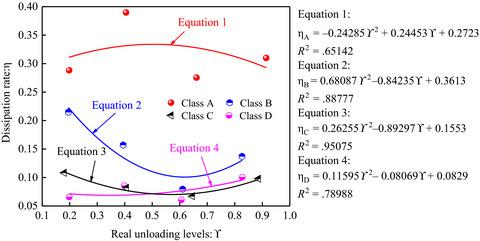当前位置:
X-MOL 学术
›
Energy Sci. Eng.
›
论文详情
Our official English website, www.x-mol.net, welcomes your feedback! (Note: you will need to create a separate account there.)
Characteristics of energy storage and dissipation of coal under one‐time cyclic load
Energy Science & Engineering ( IF 3.8 ) Pub Date : 2020-06-01 , DOI: 10.1002/ese3.738 Kang Peng 1 , Shaowei Shi 1 , Quanle Zou 1 , Junhui Mou 1 , Jin Yu 2 , Yongjiang Zhang 3 , Yanying Cheng 4, 5
Energy Science & Engineering ( IF 3.8 ) Pub Date : 2020-06-01 , DOI: 10.1002/ese3.738 Kang Peng 1 , Shaowei Shi 1 , Quanle Zou 1 , Junhui Mou 1 , Jin Yu 2 , Yongjiang Zhang 3 , Yanying Cheng 4, 5
Affiliation

|
Energy is an important research parameter in rock mechanics. To explore the law of energy evolution of coal, a one‐time loading and unloading test under uniaxial compression was conducted on coal taken from four different coal mines. By utilizing the area integral method, the total input, elastic, and dissipated energy densities in coal at different unloading levels were calculated. The correlation between various energy densities and the evolution law of energy density with different unloading levels was attained. The peak strengths of the coal slowly declined with an increasing unloading level, which conforms to the relation of a linearly decreasing function. The energy dissipation rate has nonlinear characteristics, and the shape of the dissipation rate fitting curve changed from an upper concave to a downward concave with increasing strength. In all the coal samples, the energy density grew nonlinearly with the unloading level. Moreover, the growth rate of the total energy density was the highest, followed by the growth rates of the elastic and dissipated energy densities. All ratios of the elastic and dissipated energy densities to the total input energy density and the ratio of the dissipated energy density to the elastic energy density were constant. As the strength increased, the input energy and the elastic energy density increased at a faster rate, and they observed the same law. There is an insignificant relationship between the degree of destruction of the coal and the level of unloading. Energy is a major factor that drives the failure of a test piece, but this is not the main factor that determines the degree of damage to the test piece.
中文翻译:

一次性循环荷载下煤的储能耗散特性
能量是岩石力学中重要的研究参数。为了探索煤的能量演化规律,对取自四个不同煤矿的煤进行了一次单轴压缩下的一次性装卸试验。利用面积积分法,计算了不同卸荷水平下煤的总输入能量,弹性能量和耗散能量密度。得到了不同卸荷水平下各种能量密度与能量密度演化规律之间的相关性。煤的峰值强度随卸荷水平的增加而缓慢下降,这与线性下降函数的关系一致。能量耗散率具有非线性特性,并且随着强度增加,耗散率拟合曲线的形状从上凹变为下凹。在所有煤样品中,能量密度随卸载水平呈非线性增长。此外,总能量密度的增长率最高,其次是弹性和耗散能量密度的增长率。弹性和耗散能量密度与总输入能量密度的所有比率以及耗散能量密度与弹性能量密度的比率都是恒定的。随着强度的增加,输入能量和弹性能密度以更快的速率增加,并且它们遵循相同的规律。煤的破坏程度与卸货水平之间的关系微不足道。能量是驱动试件失效的主要因素,但这不是决定试件损坏程度的主要因素。能量密度随卸载水平非线性增长。此外,总能量密度的增长率最高,其次是弹性和耗散能量密度的增长率。弹性和耗散能量密度与总输入能量密度的所有比率以及耗散能量密度与弹性能量密度的比率都是恒定的。随着强度的增加,输入能量和弹性能密度以更快的速率增加,并且它们遵循相同的规律。煤的破坏程度与卸货水平之间的关系微不足道。能量是驱动试件失效的主要因素,但这不是决定试件损坏程度的主要因素。能量密度随卸载水平呈非线性增长。此外,总能量密度的增长率最高,其次是弹性和耗散能量密度的增长率。弹性和耗散能量密度与总输入能量密度的所有比率以及耗散能量密度与弹性能量密度的比率都是恒定的。随着强度的增加,输入能量和弹性能密度以更快的速率增加,并且它们遵循相同的规律。煤的破坏程度与卸货水平之间的关系微不足道。能量是驱动试件失效的主要因素,但这不是决定试件损坏程度的主要因素。总能量密度的增长率最高,其次是弹性和耗散能量密度的增长率。弹性和耗散能量密度与总输入能量密度的所有比率以及耗散能量密度与弹性能量密度的比率都是恒定的。随着强度的增加,输入能量和弹性能密度以更快的速率增加,并且它们遵循相同的规律。煤的破坏程度与卸货水平之间的关系微不足道。能量是驱动试件失效的主要因素,但这不是决定试件损坏程度的主要因素。总能量密度的增长率最高,其次是弹性和耗散能量密度的增长率。弹性和耗散能量密度与总输入能量密度的所有比率以及耗散能量密度与弹性能量密度的比率都是恒定的。随着强度的增加,输入能量和弹性能密度以更快的速率增加,并且它们遵循相同的规律。煤的破坏程度与卸货水平之间的关系微不足道。能量是驱动试件失效的主要因素,但这不是决定试件损坏程度的主要因素。弹性和耗散能量密度与总输入能量密度的所有比率以及耗散能量密度与弹性能量密度的比率都是恒定的。随着强度的增加,输入能量和弹性能密度以更快的速率增加,并且它们遵循相同的规律。煤的破坏程度与卸货水平之间的关系微不足道。能量是驱动试件失效的主要因素,但这不是决定试件损坏程度的主要因素。弹性和耗散能量密度与总输入能量密度的所有比率以及耗散能量密度与弹性能量密度的比率都是恒定的。随着强度的增加,输入能量和弹性能密度以更快的速率增加,并且它们遵循相同的规律。煤的破坏程度与卸货水平之间的关系微不足道。能量是驱动试件失效的主要因素,但这不是决定试件损坏程度的主要因素。输入能量和弹性能量密度以更快的速度增加,它们遵循相同的规律。煤的破坏程度与卸货水平之间的关系微不足道。能量是驱动试件失效的主要因素,但这不是决定试件损坏程度的主要因素。输入能量和弹性能量密度以更快的速度增加,它们遵循相同的规律。煤的破坏程度与卸货水平之间的关系微不足道。能量是驱动试件失效的主要因素,但这不是决定试件损坏程度的主要因素。
更新日期:2020-06-01
中文翻译:

一次性循环荷载下煤的储能耗散特性
能量是岩石力学中重要的研究参数。为了探索煤的能量演化规律,对取自四个不同煤矿的煤进行了一次单轴压缩下的一次性装卸试验。利用面积积分法,计算了不同卸荷水平下煤的总输入能量,弹性能量和耗散能量密度。得到了不同卸荷水平下各种能量密度与能量密度演化规律之间的相关性。煤的峰值强度随卸荷水平的增加而缓慢下降,这与线性下降函数的关系一致。能量耗散率具有非线性特性,并且随着强度增加,耗散率拟合曲线的形状从上凹变为下凹。在所有煤样品中,能量密度随卸载水平呈非线性增长。此外,总能量密度的增长率最高,其次是弹性和耗散能量密度的增长率。弹性和耗散能量密度与总输入能量密度的所有比率以及耗散能量密度与弹性能量密度的比率都是恒定的。随着强度的增加,输入能量和弹性能密度以更快的速率增加,并且它们遵循相同的规律。煤的破坏程度与卸货水平之间的关系微不足道。能量是驱动试件失效的主要因素,但这不是决定试件损坏程度的主要因素。能量密度随卸载水平非线性增长。此外,总能量密度的增长率最高,其次是弹性和耗散能量密度的增长率。弹性和耗散能量密度与总输入能量密度的所有比率以及耗散能量密度与弹性能量密度的比率都是恒定的。随着强度的增加,输入能量和弹性能密度以更快的速率增加,并且它们遵循相同的规律。煤的破坏程度与卸货水平之间的关系微不足道。能量是驱动试件失效的主要因素,但这不是决定试件损坏程度的主要因素。能量密度随卸载水平呈非线性增长。此外,总能量密度的增长率最高,其次是弹性和耗散能量密度的增长率。弹性和耗散能量密度与总输入能量密度的所有比率以及耗散能量密度与弹性能量密度的比率都是恒定的。随着强度的增加,输入能量和弹性能密度以更快的速率增加,并且它们遵循相同的规律。煤的破坏程度与卸货水平之间的关系微不足道。能量是驱动试件失效的主要因素,但这不是决定试件损坏程度的主要因素。总能量密度的增长率最高,其次是弹性和耗散能量密度的增长率。弹性和耗散能量密度与总输入能量密度的所有比率以及耗散能量密度与弹性能量密度的比率都是恒定的。随着强度的增加,输入能量和弹性能密度以更快的速率增加,并且它们遵循相同的规律。煤的破坏程度与卸货水平之间的关系微不足道。能量是驱动试件失效的主要因素,但这不是决定试件损坏程度的主要因素。总能量密度的增长率最高,其次是弹性和耗散能量密度的增长率。弹性和耗散能量密度与总输入能量密度的所有比率以及耗散能量密度与弹性能量密度的比率都是恒定的。随着强度的增加,输入能量和弹性能密度以更快的速率增加,并且它们遵循相同的规律。煤的破坏程度与卸货水平之间的关系微不足道。能量是驱动试件失效的主要因素,但这不是决定试件损坏程度的主要因素。弹性和耗散能量密度与总输入能量密度的所有比率以及耗散能量密度与弹性能量密度的比率都是恒定的。随着强度的增加,输入能量和弹性能密度以更快的速率增加,并且它们遵循相同的规律。煤的破坏程度与卸货水平之间的关系微不足道。能量是驱动试件失效的主要因素,但这不是决定试件损坏程度的主要因素。弹性和耗散能量密度与总输入能量密度的所有比率以及耗散能量密度与弹性能量密度的比率都是恒定的。随着强度的增加,输入能量和弹性能密度以更快的速率增加,并且它们遵循相同的规律。煤的破坏程度与卸货水平之间的关系微不足道。能量是驱动试件失效的主要因素,但这不是决定试件损坏程度的主要因素。输入能量和弹性能量密度以更快的速度增加,它们遵循相同的规律。煤的破坏程度与卸货水平之间的关系微不足道。能量是驱动试件失效的主要因素,但这不是决定试件损坏程度的主要因素。输入能量和弹性能量密度以更快的速度增加,它们遵循相同的规律。煤的破坏程度与卸货水平之间的关系微不足道。能量是驱动试件失效的主要因素,但这不是决定试件损坏程度的主要因素。



























 京公网安备 11010802027423号
京公网安备 11010802027423号